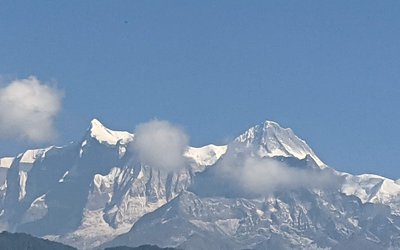On 30 September 2010, I was invited to testify before a US Congressional Committee on Foreign Affairs panel entitled “Out of the shadows: The global fight against human trafficking”. To present a fair and accurate picture of the situation, I spoke with various individuals from the Human Rights Commission, journalists reporting on the issue and policewomen involved in anti-trafficking efforts. I gleaned from each that human trafficking, especially that of women, has existed for a long time but only in recent years, it received renewed attention from NGOs, civil society, the media and the government.
Trafficking-in-person (TIP) is the worst form of human rights abuse. It is a 21st century form of human slavery. TIP dehumanizes people by violating their rights of movement, and freedom of speech, essentially turning them into a commodity. The US State Department’s Annual TIP Report cited Nepal as one the major source countries for women trafficked to India and elsewhere for commercial and sexual exploitation. The 10-year Maoist insurgency further worsened the situation as many women and children in rural areas were forced to flee to the safety of urban centers. Nepal is categorized as a Tier 2 country in the 2009 TIP Report, indicating that the Nepalese government does not yet fully comply with the Trafficking Victims Protection Re-Authorization Act’s (TVPRA) minimum standards for combating trafficking, but is making significant efforts to comply with the minimal standards for the elimination of trafficking.
Sabin Pradhan of the Forum for Women Law and Development (FWLD) said during our discussion that trafficking of women and children for commercial and sexual exploitation is a long standing tragedy in Nepal. Gender discrimination, poverty, illiteracy and unemployment render large numbers of women and girls vulnerable to trafficking and sexual exploitation. According to U.S. Department of State’s 2009 Trafficking in Persons Report, 22,500 Nepalese women, girls and children are trafficked annually for sexual exploitation. Girls in the age group 12-18 years are at most risk, and girls from marginalized groups such as the Dalits (untouchables) are most vulnerable.
The government of Nepal has comprehensive anti-trafficking legislation on the books, but a weak judicial and regulatory system and inadequate resources leads to weak enforcement. For example, the Ministry of Women, Children, and Social Welfare, the government agency primarily responsible for dealing with trafficking, has formed anti-trafficking task forces at both the national and district levels. But the annual budget for the District Task Force is just $535.
When I talked to DIG Paravati Thapa and Inspector Durga Singh Chand, both of them were very helpful, drawing from their experience and insights into the situation. Chand talked about girls as young as twelve being trafficked, many ending up as sex workers or domestic servants primarily in India. There are many organizations in Nepal working on these issues and raising awareness at the national and international level. Recently Anuradha Koirala of Maiti Nepal was nominated as one of ten CNN World Heroes and it gives me great satisfaction knowing that her fight against trafficking of women is finally being recognized.
I am part of an organization known as RHEST ( Rural Health and Education Services Trust ) a small non-governmental organization based in Kathmandu that focuses on anti-trafficking programs and women’s health issues through education and trainings . Our partner organization, the American Himalayan Foundation (AHF, USA), is a San Francisco based non-profit organization with over twenty five years of experience in helping communities and the ecology of the Himalaya. It specializes in supporting and leveraging projects related to basic health care, education, anti-trafficking, economic development and cultural preservation. These two organizations have been partnering since 1998 on an innovative anti-trafficking program called STOP Girl Trafficking. This program addresses the pervasive problem of trafficking of young girls in Nepal by combating trafficking at its source – preventing girls from becoming victims through education. The program currently supports 7,500 girls and since its inception, not a single girl has been lost to trafficking. The program has become a model, whose success is rooted in community involvement and empowerment of poor at-risk and vulnerable girls through the simple mechanism of identifying the girls and keeping them in school.
Nanu was one of hundreds of girls working as domestic laborers in Kathmandu and other cities without any access to education.
During my testimony, I was asked what the Government of Nepal’s initiatives to combat the issues were and I pointed out that the government has adopted various measures to combat trafficking of women and girls including formation of special Women Police Cell in Kathmandu and other cities to deal specifically with crime against women and children.
Another is the establishment of the Office of the National Rapporteur on Trafficking in Women and Children (ONRT) at the National Human Rights Commission in 2002. One of the objectives of this office is to coordinate national, regional and international efforts to combat trafficking in Nepal. Yet another is the establishment of special anti-trafficking task forces in collaboration with non–governmental and community-based organizations and at both the national and district levels.
There is an enhanced collaboration with International Non-Governmental Organizations and UN agencies on trafficking issues. Joining the South Asian Association for Regional Cooperation (SAARC) Convention on Preventing and Combating Trafficking in Women and Children for Prostitution has been another step. The convention was signed in Kathmandu in 2002.
It is admirable that the Nepalese government, in spite of its limited resources, is attempting to combat human trafficking. Civil society leaders, NGOs, and media are also bringing it to the forefront by highlighting the gravity of the situation. While private and public initiatives go a long way against the fight in human trafficking, only a fundamental shift in society’s values and attitudes can address the root of this problem. Education should be made a priority for all children, along with economic opportunities for adults. Further, young children and women should not be viewed as domestic commodities but as valuable members of society. Only then can we eliminate human trafficking in its worst forms.
Nanu Chaudhari (name changed) from Western Nepal was 12 years old when her father sold her to a couple in Sindhupalchok as a domestic laborer for 8000 rupees, 3 years ago. Nanu was forced to work 10 to 12 hours per day without pay and beaten severely if there were minor mistakes. She worked for years without ever having the opportunity to go to school. But one day when the male head of the household tried to rape her, it was unbearable and she fled to one of the neighbors seeking refuge. The neighbor gave her some money so that she could escape. She came to Kathmandu and managed to earn some money and went back to her village. Her father, who had previously received payments for her daughter’s domestic labor, demanded that she go back. But Nanu refused and now, with help of RHEST is studying in third grade. She says she used to be shy when she started third grade as the other children were so small, but the pain and hardships she had endured in Sindhupalchowk made her determined to pass school so that she and her sister will not have to suffer the same pain. “My father is still not happy with me and scolds me a lot but my mother supports me, and I do a lot of house hold work as well. I am grateful that I am supported by RHEST, when I will have more confidence, I will tell my story with my real name and my photograph.”
Nanu was one of hundreds of girls working as domestic laborers in Kathmandu and other cities without any access to education.
During my testimony, I was asked what the Government of Nepal’s initiatives to combat the issues were and I pointed out that the government has adopted various measures to combat trafficking of women and girls including formation of special Women Police Cell in Kathmandu and other cities to deal specifically with crime against women and children.
Another is the establishment of the Office of the National Rapporteur on Trafficking in Women and Children (ONRT) at the National Human Rights Commission in 2002. One of the objectives of this office is to coordinate national, regional and international efforts to combat trafficking in Nepal. Yet another is the establishment of special anti-trafficking task forces in collaboration with non–governmental and community-based organizations and at both the national and district levels.
There is an enhanced collaboration with International Non-Governmental Organizations and UN agencies on trafficking issues. Joining the South Asian Association for Regional Cooperation (SAARC) Convention on Preventing and Combating Trafficking in Women and Children for Prostitution has been another step. The convention was signed in Kathmandu in 2002.
It is admirable that the Nepalese government, in spite of its limited resources, is attempting to combat human trafficking. Civil society leaders, NGOs, and media are also bringing it to the forefront by highlighting the gravity of the situation. While private and public initiatives go a long way against the fight in human trafficking, only a fundamental shift in society’s values and attitudes can address the root of this problem. Education should be made a priority for all children, along with economic opportunities for adults. Further, young children and women should not be viewed as domestic commodities but as valuable members of society. Only then can we eliminate human trafficking in its worst forms.
- TANAHU HYDROPOWER PROEJCT: A Significant Achievement
- Apr 15, 2024
- AMBASSADOR HANAN GODAR: Sharing Pain With A Nepali Family
- Mar 30, 2024
- VISIT OF KfW AND EIB TO NEPAL : Mission Matters
- Mar 25, 2024
- NEPAL BRITAIN SOCIETY: Pratima Pande's Leadership
- Mar 24, 2024
- NEPAL ARMY DAY: Time To Recall Glory
- Mar 15, 2024
















